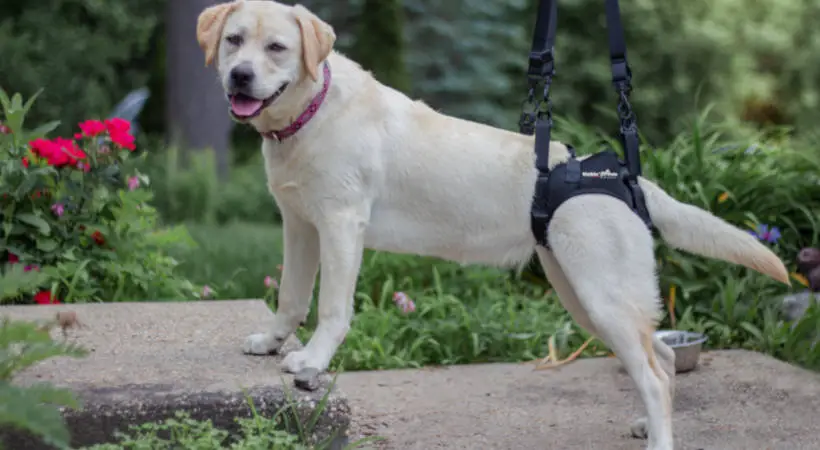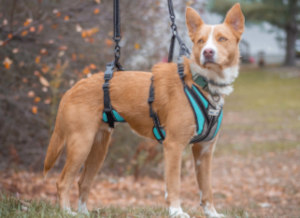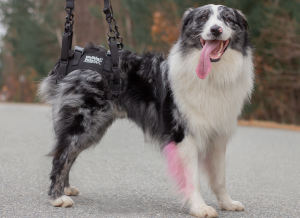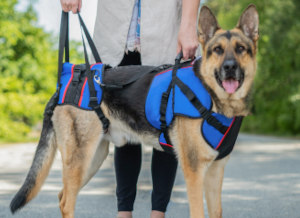Dogs with arthritis struggle with movement because of the pain resulting from the condition. As the dog parent, your part can ease movement as much as possible. That may mean that the area where the dog moves about should be as easy to navigate. However, some structural alterations to your living space are virtually impossible. For instance, the stairs – it’s challenging to upend them all together for the dog’s sake, and since more than 80% of dog owners likely have some stairs in their apartment or home, let’s look at whether stairs are bad for dogs with arthritis.
Are Stairs Bad for Dogs with Arthritis?
Yes, stairs are bad for dogs with arthritis. This is because stairs may strain the areas of the body that suffer pain during movement – mainly the joints of the limbs. Stairs are also a potential accident hazard – one that is more real because the motions of the arthritic dog are not adequately controlled. One benefit of using stairs is that they may help the arthritic dog exercise when climbing stairs. But the shortcomings of using stairs far outweigh this benefit. Ultimately, stairs are not the end of the world: the arthritic dog can use ramps to go up the stairs, or you can make the first floor cozy enough for them.
Are Stairs a Bad Idea for Arthritic Dogs?
It may depend on the kind of stairs you’re dealing with. But the bottom line is that stairs were made for humans, not dogs. Unfortunately, in the case of arthritic dogs, they pose the following threats:
1. Worsening the arthritic condition
Arthritic dogs tend to compensate for pain in one joint by shifting body weight to other limbs that are unaffected. This is particularly the case with hip dysplasia, one of dogs’ leading causes of arthritis.
Anyway, the steps of the stairs can fasten the progression of arthritis by causing more friction in the affected joints and causing imbalanced or wobbly movements.
2. Climbing up and down the stairs is painful for arthritic dogs
Arthritic dogs exert themselves when climbing up and down stairs. Even though the condition may be in its earlier stages, the pain will increase as the condition worsens.
So, it can be good in the long run to limit movements up and down the stairs.
3. Increased risk of accidents
There is always the imminent danger that the arthritic dog may fall down the stairs. Such an accident may cause additional trauma to the limbs or other parts of the body, which is catastrophic.
4. Morale
Some people suggest training arthritic and older dogs to go up the stairs when a non-slip material is placed on the stairs to help with the grip. However, the success of that strategy may depend on the extent of arthritis in the dog and how steep those stairs are.
A likely result to remember is that trying to train an arthritic dog to move up and down the stairs may make them less motivated to do any movement. Therefore, a better strategy might be to make the areas where the arthritic dog moves about easier to navigate without training.
That’s a perfect segway into a discussion of stair alternatives.
How to Help an Arthritic Dog with the Stairs
Below are some of the approaches that can solve the stairs problem for your senior or arthritic dog:
1. Installing a ramp
This is a compromise for the adventurous dog that wants to know what is going up there despite his condition. It is also beneficial since it makes the dog confident to move up and down other ramps, such as a ramp onto the car and one or two steps off the front porch, among others.
The surface of the ramp should be non-slip, and the edges should cover the steps of the stairs neatly. Be patient and supportive with the dog as they learn to use the ramp to move up and down the stairs.
2. Use a lifting aid harness
Another approach is to use a lifting aid harness. There are harnesses in the market that are designed specifically for dogs that have degenerative joint diseases such as arthritis. They are designed to ease pain and improve mobility, especially for large breeds of dogs with degenerative conditions.
A dog harness will help you take some weight off your arthritic dog’s affected limbs. Hence, it will ease mobility, improve your dog’s stability and balance, and provide support. In addition, in case you are exercising your arthritic canine friend, a dog harness will help to eliminate slipping, which may cause more injury to the affected joints.
Types of harness include:
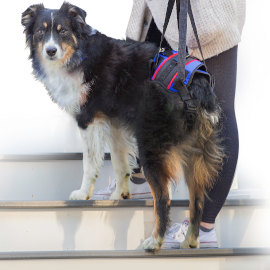
Rear support harnesses– are designed to help dogs with arthritis in their hip and hind legs. It is usually fitted around the dog’s waist. A well-designed rear support harness can help a person without much upper body strength and support a large dog breed.
Front support harnesses are designed to offer support on the front side of the dog. It fits a dog’s chest or belly area. A front lifting harness allows pet parents to support and stabilize a dog’s front legs. This is ideal for dogs with front leg weakness, arthritis, or elbow dysplasia that cannot bear full weight on their front legs.
Full body harnesses – These harnesses are designed to support dogs suffering from arthritis in all four legs. A full-body harness supports the front and back legs and is very popular for dogs with severe mobility loss that need maximum support. You should be very careful when choosing this harness since it will need to fit your dog perfectly to be effective. The harness should fit snugly so the dog can be lifted and supported on the stairs without the harness shifting.
3. Make a downstairs home for the dog
Sometimes, it would be easier to restrict a dog to the first floor and eliminate their access to the stairs. Move the sleeping area, food, and water downstairs – where the arthritic dog can roam free on flat surfaces.
These surfaces should allow your dog to maintain traction, avoid smooth flooring when possible, or place mats on the floor to help them stay on their feet. Alternately, dog boots with a rubber sole can be used inside to help your pet stay upright and grip the floor. Bedding and carpeting can help eliminate some of the cold, which is an essential benefit to arthritic dogs.
Joint pain can make it difficult for an arthritic dog to bend over to eat or drink. Consider switching to elevated bowls to raise the food and water containers so the dog can reach them without straining.
You can install a stair gate to prevent the dog from moving up the stairs when you’re not nearby. Then, if your dog needs to go with you upstairs, you can carry him up there.
Final Thoughts
Considering the ease of movement for a dog with arthritis is very important. Stairs are not recommended for a dog with that condition. They may worsen the situation by causing increased pressure, inflammation, and pain.
Therefore, although stairs may be touted as an excellent way to exercise, the best overall course of action is to prevent movement up and down the stairs. Admittedly, causes and cases of arthritis differ, and hence do the limitations of movement. So, you can ask a licensed vet to assess how your dog may be affected by such actions, depending on the causes of arthritis in your dog and its progression.
Keeping the dog motivated by assuring him of his excellent mobility on flat surfaces downstairs and his mood will be beneficial in dealing with the limitations of arthritis.

